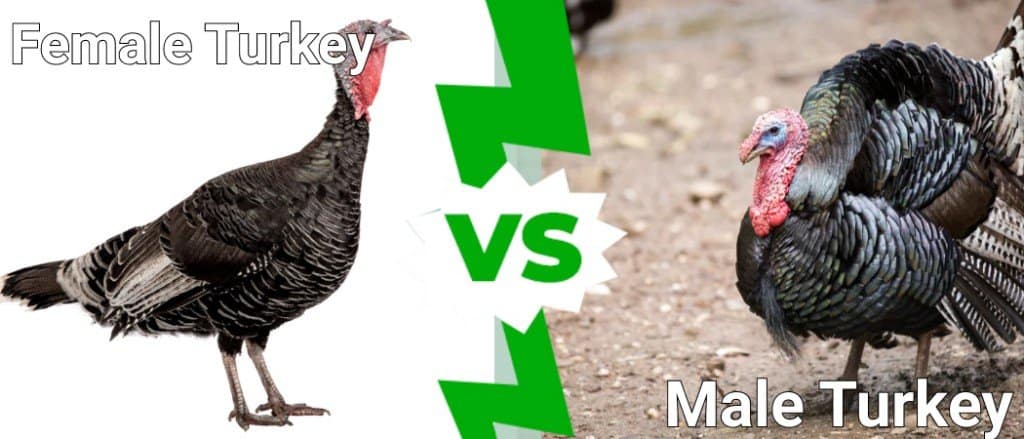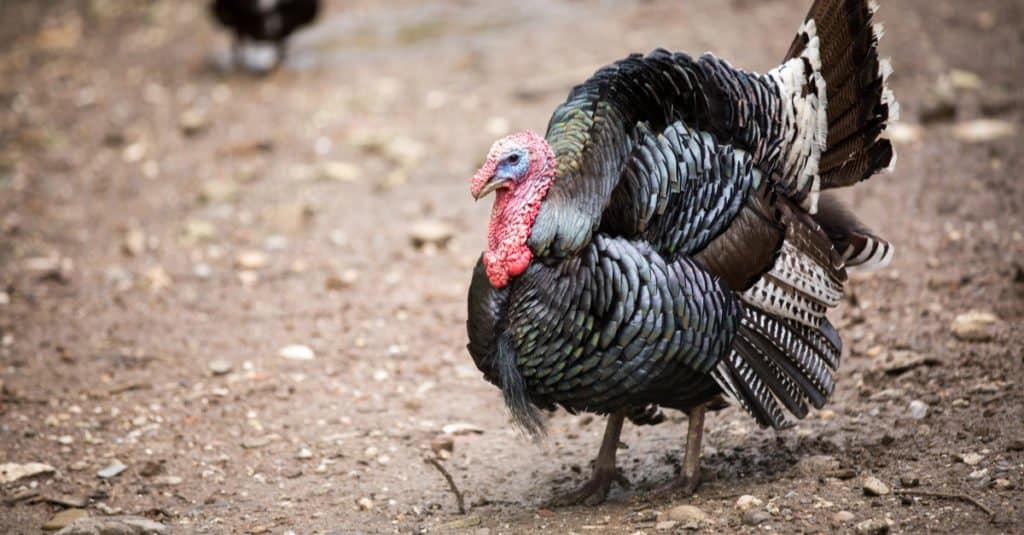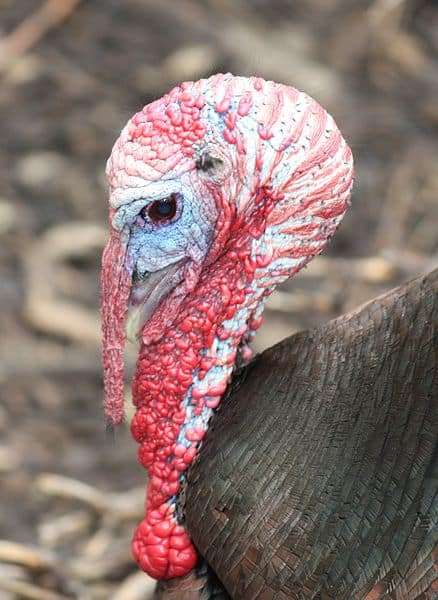
Figuring out the difference between male vs female turkeys is easy in adult birds. Male turkeys are much larger and have more elaborate plumage. But there are a lot of differences between male and female turkeys that you can spot both in adult turkeys and even hatchlings!
Male VS Female Turkeys: Adult Birds
Unbelievably, there are quite a few ways to tell the difference between male and female turkeys! There are even ways to tell the sex of a turkey that has been in an area without seeing the turkey itself. Additionally, identifying a male turkey vs a female turkey is easier when trying to tell the difference between adult birds.
Male Turkeys Are Always Larger Than Females

Male turkeys are significantly bigger than female turkeys, across both species and in the case of wild and domesticated turkeys.
©Matthew Clemente/Shutterstock.com
The easiest way to tell whether a turkey is male, or female is its size. Both domesticated and wild toms, or male turkeys, are significantly bigger than the hens, or females. Male domesticated turkeys weigh 30 to 80 pounds and are around forty-five inches long. Domesticated females are thirty-five inches long and weigh around eighteen pounds.
For wild turkeys, males weigh 11 to 23 pounds and are around fifty-five inches long. Wild females are also around thirty-five inches long and weigh eleven pounds. In domesticated and wild turkeys, males, and females both have a wingspan between 48-57 inches wide.
Ocellated turkeys are the smallest type of turkeys. Males weigh up to thirteen pounds and females weigh 6 to 8 pounds. Both males and females are 24 to 36 inches long with a wingspan of 26 to 30 inches.
Female Turkeys Do not Have Elaborate Tail Plumage

While male turkeys have more impressive plumage and display distinctive tail fan, only females have head feathers. All male turkeys are completely bald!
Male turkeys are most easily distinguished from females by their impressive tails. Toms have quite elaborate, brightly colored plumage, which is quite common in many bird species. Hens have duller feathers with shorter tail plumage. The exact coloration depends on the species, though non-domesticated males usually have striped wing feathers.
While hens can spread their tails to form the signature fan shape, they will rarely do so. Male turkeys will always have a breast beard as well, while very few hens do. Hens also have feathers on their heads, whereas toms do not. Male turkeys are always completely bald!
Male Turkeys Have Spurs
Toms can also be identified by their “spurs,” which are claw-like protrusions on the sides of the ankle. Male turkeys use these spurs to fend off attacks and guard hens in the same way roosters do. Both male and female turkeys will have a tuft of feathers under the beak called a beard. Males and females also have a fleshy growth on the top of the beak called a snood.
Only Male Turkeys Can Gobble!
The male turkey also has a distinct waddle under the neck. Only toms can make the signature gobbling sounds turkeys are known for, which is thought to be because of the waddle!
Male Vs Female Turkeys: You Can Tell Them Apart Without Seeing Them!
You can even tell the difference between a tom and a hen without seeing the bird itself. Admittedly, it is kind of gross, but if you are tracking or hunting a wild turkey this is important to know!
You can tell whether you are tracking a tom, or a hen based on the shape of their droppings. Male turkeys have droppings that fall in a distinct J-shape, while females produce droppings in a spiral shape.
This is where the gross part comes in. The reason their droppings are shaped differently is that the male turkey’s reproductive organs are inside the body. This is common in many bird species and is thought to be why their droppings are shaped differently.
Male VS Female Turkeys: How To Tell Baby Turkeys Apart

There are a few ways to sex poults, but the most accurate way to tell the sex of a baby turkey should be done by an expert to avoid hurting the bird or injuring them.
©Ariusz Nawrocki/Shutterstock.com
Accurately sexing baby turkeys, or poults is not considered to be a straightforward process. Like sexing chickens, verifying a male vs a female turkey poult causes some pain to the bird and can cause damage if not done right. Most people hire a professional poultry sexer for this test.
Both male and female poults have a vertical slit that is used for both elimination and reproduction. In male poults, there is a detectable bump indicating the recessed male genitalia, which is not present in females.
Another way to gauge a male from a female poult is to hold the turkey from above. If the legs dangle down, it is female. While this is not exact, it can give you a general idea of the sex of the poult.
Teenage Turkeys: Male Or Female?
Telling the difference between a male or female juvenile turkey is like adult turkeys. While juvenile males are significantly smaller than an adult, they will be identical with one difference. Juvenile males have uneven tail fans, while adult toms have feathers that are uniform in size.
Female juveniles look exactly like their adult counterparts but are significantly smaller.
Do Male Turkeys Need To Be Separated From Each Other?
Toms should not be kept in pens together and will become aggressive if in contact with each other. Male turkeys are very territorial and will fight over females just like roosters. Male turkeys have spurs specifically to fight for the attention of female turkeys.
Female turkeys do not need spurs because they will never fight for a mate. Turkeys are not monogamous.
Are Cooked Turkeys Male or Female?
Both female (hens) and male (toms) turkeys are part of our diet, but hens are typically the more prevalent choice for our dinner tables. If you’re looking to feed a large family, a tom turkey is the ideal choice for a substantial bird.
Mature females, known as hens, are typically sold as whole birds, with an average weight of around 15 pounds.
In contrast, the males, referred to as toms as they grow, are destined to be transformed into cutlets, deli meats, and processed items such as turkey dogs and sausages, with an average weight of approximately 30 pounds.
Most store-bought brands sell young turkey hens for general consumption.
The photo featured at the top of this post is © Brent Coulter/Shutterstock.com
Thank you for reading! Have some feedback for us? Contact the AZ Animals editorial team.







